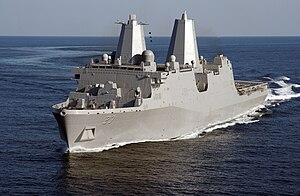
Splashdown is the method of landing a spacecraft by parachute in a body of water. It was used by crewed American space capsules prior to the Space Shuttle program, by the SpaceX Dragon 1 and Dragon 2 capsules and by NASA's Orion Multipurpose Crew Vehicle. It is also possible for the Russian Soyuz spacecraft to land in water, though this is only a contingency. The only example of an unintentional crewed splashdown in Soviet history is the Soyuz 23 landing.

Ingalls Shipbuilding is a shipyard located in Pascagoula, Mississippi, United States, originally established in 1938, and now part of HII. It is a leading producer of ships for the United States Navy, and at 12,500 employees, the second-largest private employer in Mississippi.

The San Antonio class is a class of amphibious transport docks, also called a "landing platform, dock" (LPD), used by the United States Navy. These warships replace the Austin-class LPDs, as well as the Newport-class tank landing ships, the Anchorage-class dock landing ships, and the Charleston-class amphibious cargo ships that have already been retired.

USS Green Bay (LPD-20) is a San Antonio-class amphibious transport dock. She is the second ship of the United States Navy to be named for the city and bay of Green Bay, Wisconsin.

USS San Antonio (LPD-17), the lead ship of her class of amphibious transport dock or landing platform dock, is the first ship of the United States Navy to be named for the city of San Antonio, Texas.

USS New Orleans (LPD-18), a San Antonio-class amphibious transport dock, is the fourth commissioned ship of the United States Navy to be named after the city of New Orleans, Louisiana.

USS Mesa Verde (LPD-19) is the third San Antonio-class amphibious transport dock of the United States Navy. She is the first U.S. Navy warship to be named after the Mesa Verde National Park in the U.S. state of Colorado.

USS New Orleans (LPH-11) was an Iwo Jima-class amphibious assault ship in the United States Navy. She was the third Navy ship to be so named, and is the first named for the Battle of New Orleans, which was the last major battle of the War of 1812.
Northrop Grumman Ship Systems (NGSS) was a former sector or division of Northrop Grumman Corporation which was responsible for building small and medium shipping products. It was merged with another sector of Northrop Grumman, Northrop Grumman Newport News, which was responsible for building nuclear submarines and supercarriers, to form the sector Northrop Grumman Shipbuilding.
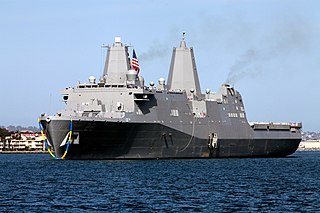
USS San Diego (LPD-22), a San Antonio-class amphibious transport dock, is the fourth ship of the United States Navy to be named for San Diego, California.

USS Arlington (LPD-24), a San Antonio-class amphibious transport dock, is the third ship of the United States Navy to be named for Arlington County, Virginia, the location of the Pentagon and the crash site of American Airlines Flight 77 during the terrorist attacks on 11 September 2001. Like her sister ships, USS New York and Somerset, she is named in commemoration of the attacks. Steel taken from the Pentagon after the attacks is displayed aboard in the ship's museum.

The USS Somerset (LPD-25) is a San Antonio-class amphibious transport dock of the United States Navy. It is the fourth Navy vessel and the second warship to bear this name, the first two being a wooden-hulled motorboat and a ferry.
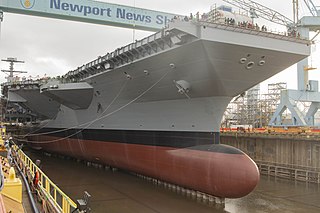
USS John F. Kennedy (CVN-79) is the second Gerald R. Ford-class aircraft carrier built for the United States Navy. The ship was launched on 29 October 2019, and christened on 7 December 2019.
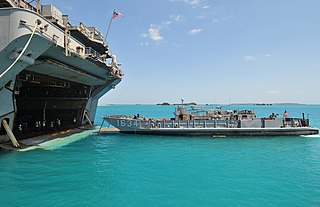
In modern amphibious warfare usage, a well dock or well deck, officially termed a wet well during U.S. Navy instruction when the well deck is flooded for operations, is a hangar-like deck located at the waterline in the stern of some amphibious warfare ships. By taking on water the ship can lower its stern, flooding the well deck and allowing vessels such as boats and landing craft, amphibious vehicles, and recovered spacecraft crew capsules to dock within the ship.

USS John P. Murtha (LPD-26) is the 10th San Antonio-class amphibious transport dock ship of the United States Navy, and is named in honor of Congressman John Murtha (1932–2010) of Pennsylvania. John P. Murtha is homeported at Naval Base San Diego.

Huntington Ingalls Industries, Inc. (HII) is the largest military shipbuilding company in the United States as well as a provider of professional services to partners in government and industry. HII, ranked No. 375 on the Fortune 500, was formed on 31 March 2011, as a divestiture from Northrop Grumman.
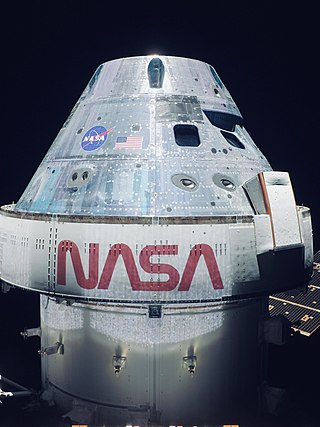
Orion is a partially reusable crewed spacecraft used in NASA's Artemis program. The spacecraft consists of a Crew Module (CM) space capsule designed by Lockheed Martin and the European Service Module (ESM) manufactured by Airbus Defence and Space. Capable of supporting a crew of four beyond low Earth orbit, Orion can last up to 21 days undocked and up to six months docked. It is equipped with solar panels, an automated docking system, and glass cockpit interfaces modeled after those used in the Boeing 787 Dreamliner. A single AJ10 engine provides the spacecraft's primary propulsion, while eight R-4D-11 engines, and six pods of custom reaction control system engines developed by Airbus, provide the spacecraft's secondary propulsion. Orion is intended to launch atop a Space Launch System (SLS) rocket, with a tower Launch escape system.

Exploration Flight Test-1 or EFT-1 was the first test flight of the crew module portion of the Orion Multi-Purpose Crew Vehicle. Without a crew, it was launched on December 5, 2014, at 12:05 UTC, by a Delta IV Heavy rocket from Space Launch Complex 37B at Cape Canaveral Space Force Station.

USS Portland (LPD-27) is a San Antonio-class amphibious transport dock ship of the United States Navy, named after the U.S. city of Portland, Oregon.
